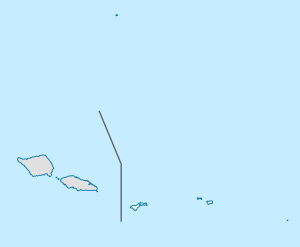Faga'itua, American Samoa
Faga'itua is a village in the east of Tutuila Island, American Samoa. It is located on the central coast of Faga'itua Bay. It is in Sua County,[1] a county also known as ‘o le falelima i sasa’e (“the house of the five in the east”). Fagaitua is located at a shallow bay on the south coast of the island, in-between Lauli'i and Alofau. It is home to Luafagā, Le’iato's house of chiefs, and the big malae Malotumau.[2]
Faga'itua | |
|---|---|
Village | |
 Faga'itua | |
| Coordinates: 14°16′03″S 170°36′50″W | |
| Country | |
| Territory | |
| County | Sua |
| Area | |
| • Total | 0.53 sq mi (1.37 km2) |
| Elevation | 26 ft (8 m) |
| Population (2010) | |
| • Total | 433 |
| • Density | 820/sq mi (320/km2) |
| Time zone | UTC−11 (Samoa Time Zone) |
| ZIP code | 96799 |
| Area code(s) | +1 684 |
Coral reefs at Faga'itua suffered significant damage during the 2009 tsunami.[3]
Faga'itua is home to the smallest and most rural high school in American Samoa. Faga'itua High School, whose student body is around 500 as of 2018, practices football at the old rugby field by Pago Pago Bay. It has never had its own field but has utilized the uneven turf at Onesosopo Park, which is replete with volcanic stubble, water, toads, and sand traps. Rob Shaffer was hired as a teacher by Faga'itua in February 1972 and eventually also took over coaching of the high school's football team. Shaffer has played varsity as a quarterback for Oceanside High School under head coach Herb Meyer.[4]
The high school's football team, the Faga'itua Vikings, has won more titles than any other high school team in American Samoa, despite being one of the smallest schools and lacking its own football field.[5]
In 2018, a monument was made for the Faga’itua High School Alumni Association in order to commemorate Faga’itua High School's 50th anniversary. The statue will eventually be mounted onto the pedestal which was designed and constructed by the American Samoa Department of Public Works. It is located in front of Faga’itua High School. The statue depicts a Viking warrior with his head tilted towards the east and the Eastern Star. The statue was made locally on Tutuila Island.[6]
Demographics
| Population growth[7] | |
|---|---|
| 2010 | 433 |
| 2000 | 483 |
| 1990 | 455 |
| 1980 | 422 |
| 1970 | 302 |
| 1960 | 309 |
| 1950 | 255 |
| 1940 | 212 |
| 1930 | 152 |
References
- Tu’u’u, Misilugi Tulifau Tofaeono (2002). History of Samoa Islands: Supremacy & Legacy of the Malietoa (na Fa'alogo i Ai Samoa). Tuga'ula Publication. Page 427. ISBN 9780958219914.
- Krämer, Augustin (2000). The Samoa Islands. University of Hawaii Press. Page 426. ISBN 9780824822194.
- http://www.radionz.co.nz/international/pacific-news/186945/american-samoan-coral-damage-reassessed
- Ruck, Rob (2018). Tropic of Football: The Long and Perilous Journey of Samoans to the NFL. The New Press. ISBN 9781620973387.
- https://www.civilbeat.org/2019/08/how-did-american-samoa-become-a-wellspring-for-football-talent/
- http://www.samoanews.com/local-news/commemorative-monument-sparks-criticism-some-fhs-alums
- "American Samoa Statistical Yearbook 2016" (PDF). American Samoa Department of Commerce.